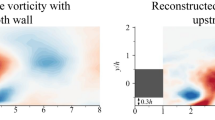Abstract
Isolated surface roughness in a laminar boundary layer can create a wedge of turbulence that spreads laterally into the surrounding laminar flow. Some recent studies have identified high- and low-speed streaks along the exterior of turbulent wedges. In this experiment, developing turbulent wedges are measured to observe the creation of these streaks. Naphthalene shear stress surface visualization and hotwire measurements are utilized to investigate the details of turbulent wedges created by cylinders in a laminar flat-plate boundary layer. Both the surface visualization and the hotwire measurements show high- and low-speed streaks in the wake of the cylinder that devolve into a turbulent wedge. The turbulent wedge spreading is associated with the emergence of these high- and low-speed streaks along the outside of the wedge. As the wedge evolves in the streamwise direction, these streaks persist inside of the core of the wedge, while new, lower amplitude streaks form along the outside of the wedge. Adding asymmetry to the cylinder moved the virtual origin closer to the roughness and increased the vortex shedding frequency, while adding small-scale roughness features did not strongly affect turbulent wedge development. Intermittency calculations additionally show the origin of the turbulent core inside of the wedge. The structure and spacing of the high-speed streaks along the extremities of the turbulent wedge give insight into the spreading angle of the turbulent wedge.













Similar content being viewed by others
References
Adrian RJ, Marusic I (2012) Coherent structures in flow over hydraulic engineering surfaces. J Hydraul Res 50(5):451–464
Charters A (1943) Transition between laminar and turbulent flow by transverse contamination. Naca technical report 891
Chong T, Zhong S (2003) On the three-dimensional structure of turbulent spots. In: ASME Turbo Expo 2003, collocated with the 2003 international joint power generation conference, American Society of Mechanical Engineers, pp 789–797
Chu JC, Goldstein DB (2012) Investigation of turbulent wedge spreading mechanism with comparison to turbulent spots. AIAA paper 2012-0751
Downs R III, White EB (2013) Free-stream turbulence and the development of cross-flow disturbances. J Fluid Mech 735:347–380
Furuya Y, Miyata M (1972) Visual studies on the wake of a roughness element proximate to a wall. Memo Fac Eng Nagoya Univ 24:278–293
Gad-El-Hak M, Blackwelderf RF, Riley JJ (1981) On the growth of turbulent regions in laminar boundary layers. J Fluid Mech 110:73–95
Ganapathisubramani B, Hutchins N, Hambleton W, Longmire E, Marusic I (2005) Investigation of large-scale coherence in a turbulent boundary layer using two-point correlations. J Fluid Mech 524:57–80
Gregory N, Walker W (1956) The effect on transition of isolated surface excrescences in the boundary layer. Aeronautical research council report and memoranda
Hunt LE, Downs III RS, Kuester MS, White EB, Saric WS (2010) Flow quality measurements in the klebanoff–saric wind tunnel. AIAA paper 2010-4538
Hutchins N, Marusic I (2007) Evidence of very long meandering features in the logarithmic region of turbulent boundary layers. J Fluid Mech 579:1–28
Klebanoff PS, Cleveland WG, Tidstrom KD (1992) On the evolution of a turbulent boundary layer induced by a three-dimensional roughness element. J Fluid Mech 237:101–187
Kuester MS, White EB (2014) Active noise control in a closed-circuit wind tunnel. AIAA J 52(9):1829–1838
Kuester MS, White EB (2015) Roughness receptivity and shielding in a flat plate boundary layer. J Fluid Mech 777:430–460
Mejia-Alvarez R, Christensen K (2013) Wall-parallel stereo particle-image velocimetry measurements in the roughness sublayer of turbulent flow overlying highly irregular roughness. Phys Fluids 25(11):115109 (1994-present)
Morkovin MV (1993) Bypass-transition research: issues and philosophy. In: Ashpis DE (ed) Instabilities and turbulence in engineering flows. Springer, Dordrecht, pp 3–30
Ramesh O, Dey J, Prabhu A (1996) Transitional intermittency distribution in a three-dimensional constant pressure diverging flow. Exp Fluids 21(4):259–263
Robinson SK (1991) Coherent motions in the turbulent boundary layer. Annu Rev Fluid Mech 23(1):601–639
Schubauer GB, Klebanoff P (1956) Contributions on the mechanics of boundary-layer transition. NACA technical report 1289
Tani I (1969) Boundary-layer transition. Ann Rev Fluid Mech 1(1):169–196
Watmuff J (2004) Evolution of a turbulent wedge from a streamwise streak. In: Proceedings of the fifteenth australasian fluid mechanics conference. The University of Sydney, pp 13–17
White EB (2000) Breakdown of crossflow vortices. Ph.D. thesis, Arizona State University, Tempe, AZ
Willingham D, Anderson W, Christensen KT, Barros JM (2014) Turbulent boundary layer flow over transverse aerodynamic roughness transitions: induced mixing and flow characterization. Phys Fluids 26(2):025111 (1994-present)
Wu Y, Christensen K (2010) Spatial structure of a turbulent boundary layer with irregular surface roughness. J Fluid Mech 655:380–418
Zhong S, Chong T, Hodson H (2003) A comparison of spreading angles of turbulent wedges in velocity and thermal boundary layers. J Fluids Eng 125(2):267–274
Acknowledgments
The authors would like to acknowledge the support of the Air Force Office of Scientific Research through AFOSR Grant FA9550-11-1-0203. The authors would also like to thank Dr. David Goldstein and Jeff Chu from the University of Texas at Austin for fruitful discussions regarding this work.
Author information
Authors and Affiliations
Corresponding author
Rights and permissions
About this article
Cite this article
Kuester, M.S., White, E.B. Structure of turbulent wedges created by isolated surface roughness. Exp Fluids 57, 47 (2016). https://doi.org/10.1007/s00348-016-2140-x
Received:
Revised:
Accepted:
Published:
DOI: https://doi.org/10.1007/s00348-016-2140-x




